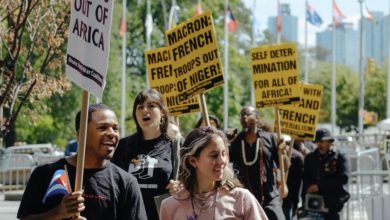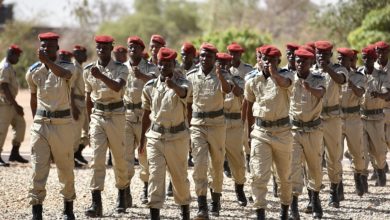Conflict in the Horn of Africa is escalating rapidly. A power struggle in Somalia between the weak interim government and the Union of Islamic Courts is on the verge of erupting into a regional war.
Somalia’s interim government, the Transitional Federal Government, was formed in exile in 2004. Since then, its
|
For the United States, with a renewed interest in the colonization of Africa, Somalia is of key geo-political importance, lying at a commercial crossroads between the Middle East and Asia. A large portion of the world’s oil tankers pass along its coast, particularly European and Chinese.
The U.S. government recognized the TFG’s weakness and impotence early on. Rather than supporting an unpopular interim government, Washington forged alliances with several factional leaders in Mogadishu, creating the Alliance for the Restoration of Peace and Counter Terrorism.
In May 2006, the Washington Post revealed that these proxy forces were secretly backed by the U.S. government. “Subsequent news reports stated that CIA operatives had flown into Somalia to give large amounts of cash to the Anti-Terrorist Alliance.”
As in Iraq, Sudan and elsewhere, “countering terrorism” has become a pretext for a new U.S. intervention in Somalia.
Somalis bitterly remember the last bloody U.S. intervention. On Oct. 3, 1993, under the pretext of a “humanitarian mission,” the U.S. military and U.N. forces under U.S. leadership left over 1,000 Somalis dead and several thousand injured, mostly civilians, in a botched attempt to assassinate Gen. Mohammed Farah Aidid, the leader of guerrilla group opposed to U.S. and U.N. occupation.
The Somali people’s reaction to U.S. support for proxy forces in Mogadishu, in violation of a 15-year-old U.N. weapons ban, was overwhelming. Richard Dowden of the Royal African Society wrote in the June 21 London Independent, “In May [2006] young men with guns poured into the capital from all over Somalia to attack the warlords. After a few fierce battles, it was all over. At a stroke Washington had achieved the very opposite of what it intended.” The Anti-Terror Alliance backed by the U.S. was defeated and run out of Somalia.
The Union of Islamic Courts
Somalia has not had a central government since 1991 when the government of former president Siad Barre was toppled. After Somalia’s central government collapsed, authority fell into the hands of a dozen guerrilla groups, each based on a particular clan.
The last 15 years have been disastrous for the Somali people, most of whom live in extremely poor and underdeveloped conditions. The U.N. News Service reported that Somalia has one of the lowest primary school enrolment rates in the world; infant, child, and mortality rates are among the highest in the world; life expectancy in Somalia is estimated at 48 years.
Over the past few years, in response to the violence and relentless fighting between guerilla groups, the Union of Islamic Courts emerged as Somalia’s strongest fighting force. Funded by business people desperate for some semblance of order, the Courts have gained widespread popularity because they offered stability and clamped down on criminal gangs and lawlessness.
Since the U.S.-backed Anti-Terror Alliance was run out of Mogadishu in June, the Courts have taken control of most of southern Somalia. The Courts reopened Mogadishu’s main airport after being closed for 11 years. In August, hundreds of people welcomed the first ship to arrive at the main port in Mogadishu in more than 10 years.
A new U.S. strategy
The U.S. State Department, following the defeat of the Anti-Terror Alliance, assembled the Somalia Contact Group, made up of the United States, Italy, Britain, Sweden and Norway. Tanzania was the token African participant. The African Union, the Arab League, and the Inter-Governmental Authority on Development—the group of neighboring African countries with interest in Somalia—were only given observer status.
The Contact Group called for an immediate end to the fighting and for peace talks. At the same time, the United States has encouraged neighboring Ethiopia to send thousands of troops into Somalia. Ethiopia is a key Washington ally in the so-called war on terror.
Ethiopia currently has 25,000 troops stationed on Somalia’s border. According to the International Crisis Group in
 |
In July, prime minister of the TFG Ali Mohamed Gedi allowed thousands of Ethiopian troops to enter Baidoa in an attempt to prop up his powerless government. Immediately thereafter, 40 members of his cabinet resigned in protest, leaving the TFG thoroughly discredited.
The Islamic Courts, which had already participated in a first round of peace negotiations in Khartoum, then withdrew from the talks. The Courts said there could be no peace talks while a foreign army occupied the country. Sheik Abdulkadir Ali, the UIC’s vice-chairman stated, “The UIC was fully supportive of continuing with the dialogue but we cannot negotiate with a gun to our head.”
Occupying Somalia with U.N. troops
Former U.S. ambassador to the United Nations John Bolton has said that not intervening in Somalia is not an option. On Dec. 6, a U.S.-backed draft U.N. resolution was approved by the Security Council. The resolution partially lifted the arms embargo on Somalia and called for an 8,000-person-strong regional “peacekeeping” force to occupy the country.
Jendayi Frazer, the U.S. assistant secretary of state for African affairs, elucidated the intentions of the “peacekeeping” force. She said that the U.S. government’s goal is to establish a balance of military might between the powerful Union of Islamic Courts and the fragile government in the country.
In other words, the “peacekeepers” and the lifting of the arms embargo are meant to strengthen the TFG, the authority of which is completely dependant on foreign military support.
The Arab League and other international organizations have warned that the resolution could lead to a civil war. This possibility, combined with massive flooding that recently displaced 500,000 people, could lead to a humanitarian crisis in the country.
The U.S. government still pushed through the U.N. resolution targeting Somalia. Hours after the resolution passed, fighting erupted between the Islamic Courts and pro-interim government forces backed by Ethiopian troops in Dinsor—a town the Islamic Courts gained control of without encountering any resistance or firing a single shot.
In a press conference held at the Islamic Courts’ main headquarters in Mogadishu on Dec. 11, the UIC chairperson for security affairs, Sheik Mohammed Siad Indhoadde, said, “The Ethiopian government must pull out of Somalia in seven days, and then we can talk if it wants peace, but if it does not withdraw its forces from Somalia within seven days, the Islamic Courts will decide how they can evict Ethiopians out of Somalia.”
The United States is attempting to frame its intervention in the region as a mission against terrorism by drawing imaginary links between the Union of Islamic Courts and Al-Qaeda. In doing this, it labels all those who resist U.S. hegemony as “terrorists.”
The tactic attempts to discredit the UIC, which enjoys popular support in much of southern and central Somalia.
Revolutionaries and progressives in the United States should not be duped by this or any other U.S. government demonization campaign. Our duty in the United States is to resist the march of imperialism in Africa and around the world, and to uphold the right of oppressed nations to self-determination.






